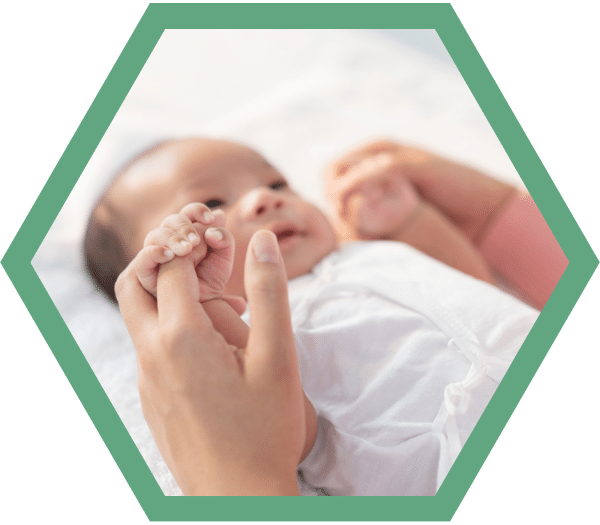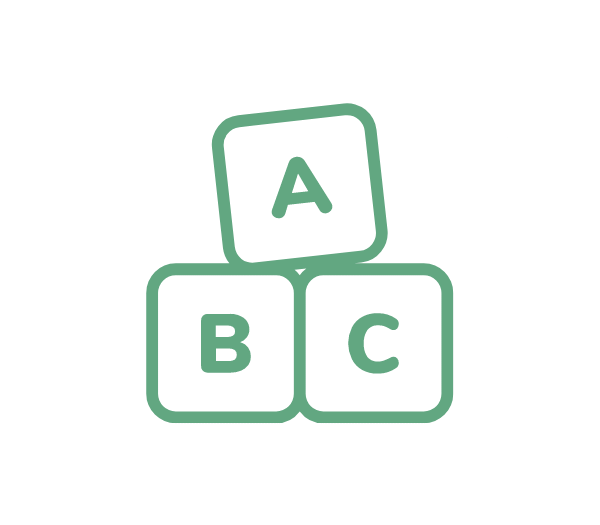
Toy and play information
Children aged
0 to 3 months
At this age the baby is learning really fast. They need your help and guidance.

Play ideas
Interacting with faces
How does it help the baby?
Helping my baby learn through interacting
Tips:
- Expensive toys are not needed – your face is the best toy for your baby!
- Your baby loves looking at, exploring and touching your face.
- Your baby loves hearing your voice and it helps your baby develop language.
- Pause when talking to your baby and wait for your baby to respond and take a turn – this is the beginning of a conversation.
Scroll down to read more.
Interesting things to look at
How does it help the baby?
Helping my baby learn through looking
Tips:
- Young babies like interesting things to look at and contrasting patterns.
- It helps visual attention and learning skills.
- Pictures should be about 30cm from your baby’s face.
Note: ensure pictures are not too close to your baby’s face and use them only a few minutes at a time when your baby is looking and interested.
Scroll down to read more.
Play mat
How does it help the baby?
Helping my baby learn through exploring
Tips:
- It promotes reaching, grasping and visual stimulation.
- It helps with learning to bring hands to the middle.
- It stimulates lifting legs to kick toys.
- Change position of the toys to promote exploration and visual interest.
Scroll down to read more.
Rattles and teethers
How does it help the baby?
Helping my baby learn through using their hands
Tips:
- It promotes reaching and grasping.
- When your baby holds a toy, it draws attention to your baby’s hands.
- It stimulates using hands to bring an object to mouth.
- Toys that make a gentle noise like rattles help your baby begin to develop an understanding of cause and effect.
Scroll down to read more.
Tummy time when awake
How does it help the baby?
Helping my baby get ready to crawl
Tips:
- It helps to become comfortable with lying on tummy.
- It provides an opportunity to develop head control and arm strength.
Note: Try this frequently and for short periods throughout the day within your baby’s tolerance.
Scroll down to read more.
Did you know?
Babies learn in the context of a relationship so talking, playing and affectionate touching will develop your babies cognitive, language and motor skills.
Tips and ideas
Play together in a variety of positions
Cradle hold – Place your baby’s head in elbow, holding his/her body with both hands.
Tiger in a tree hold – Lay baby across arm with your hand separating their legs, place your other hand on the baby’s back for support.
Shoulder hold – Rest your baby’s head on your shoulder, supporting the head and neck with your other hand.
Lap hold – Place your baby’s head by your knees, supporting with both hands.
Things to remember
When picking your baby up – Ensure that your baby’s body touches the surface before their head. Otherwise, it might startle your baby.
Lots of skin-to-skin time – Your baby rests against your bare chest, covering yourselves with a blanket. This regulates heartbeat, breathing, temperature. It promotes bonding between you and your baby.
Social-emotional growth – Babies at this age usually show growing self-regulation and interest in the world by smiling at people and bringing hands to the mouth to provide calming effects.
Boost your baby’s brain
Frequent face-to-face time – This helps form a loving and close relationship. Use this time to talk and sing to your baby.
Talking activities – Talk through actions with your baby while changing nappies, feeding, etc. Repeat sounds made by your baby Take turns in talking.
Dancing with your baby – Sway smoothly with your baby in your arms within their tolerance, giving them breaks to adjust to the movements.
Did you know?
Babies love attention and thrive when their communication attempts such as looking and making noises are responded to.
Remember that expensive toys are not needed: your face and voice, a walk in the park watching the leaves move will all be very interesting to your baby.
The advice on this page has been created by B. Hutchon and S. Powell, Royal Free London, together with Dr. A. Fernandez, Neonatologist San Jose Hospital, Chile.

